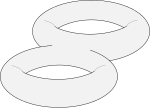% illustration of a double torus, obtained as an isosurface
function main()
% big and small radii of the torus
R = 3; r = 1;
% c controls the transition from one ring to the other
c = 1.3*pi/2;
Kb = R+r;
h = 0.1; % h is the grid size. Smaller h means prettier picture.
X = (-Kb-h):h:(3*Kb+h); m = length(X);
Y = (-Kb-h):h:(Kb+h); n = length(Y);
Z = (-r-h):h:(r+h); k = length(Z);
W = zeros(m, n, k); % the zero level set of this function will be the desired shape
for i=1:m
for j=1:n
x = X(i); x = my_map(x, Kb, c); % map from two torii to one torus
y = Y(j);
W(i, j, :) = (sqrt(x^2+y^2)-R)^2 + Z.^2-r^2; % torus eqn, vectorize in Z
end
end
figure(4); clf; hold on; axis equal; axis off;
H = patch(isosurface(W, 0));
isonormals(W, H);
light_green=[184, 224, 98]/256;
% set some propeties
set(H, 'FaceColor', light_green, 'EdgeColor','none', 'FaceAlpha', 1);
set(H, 'SpecularColorReflectance', 0.1, 'DiffuseStrength', 0.8);
set(H, 'FaceLighting', 'phong', 'AmbientStrength', 0.3);
set(H, 'SpecularExponent', 108);
daspect([1 1 1]);
axis tight;
colormap(prism(28))
% viewing angle
view(-165, 42);
% add in a source of light
camlight (-50, 54); lighting phong;
% save as png
print('-dpng', '-r500', sprintf('Double_torus_illustration.png'));
% This function constructs the second ring in the double torus
% by mapping from the first one.
function y=my_map(x, K, c)
if x > K
x = 2*K - x;
end
if x < K-c
y = x;
else
y = (K-c) + sin((x - (K-c))*(pi/2/c));
end



